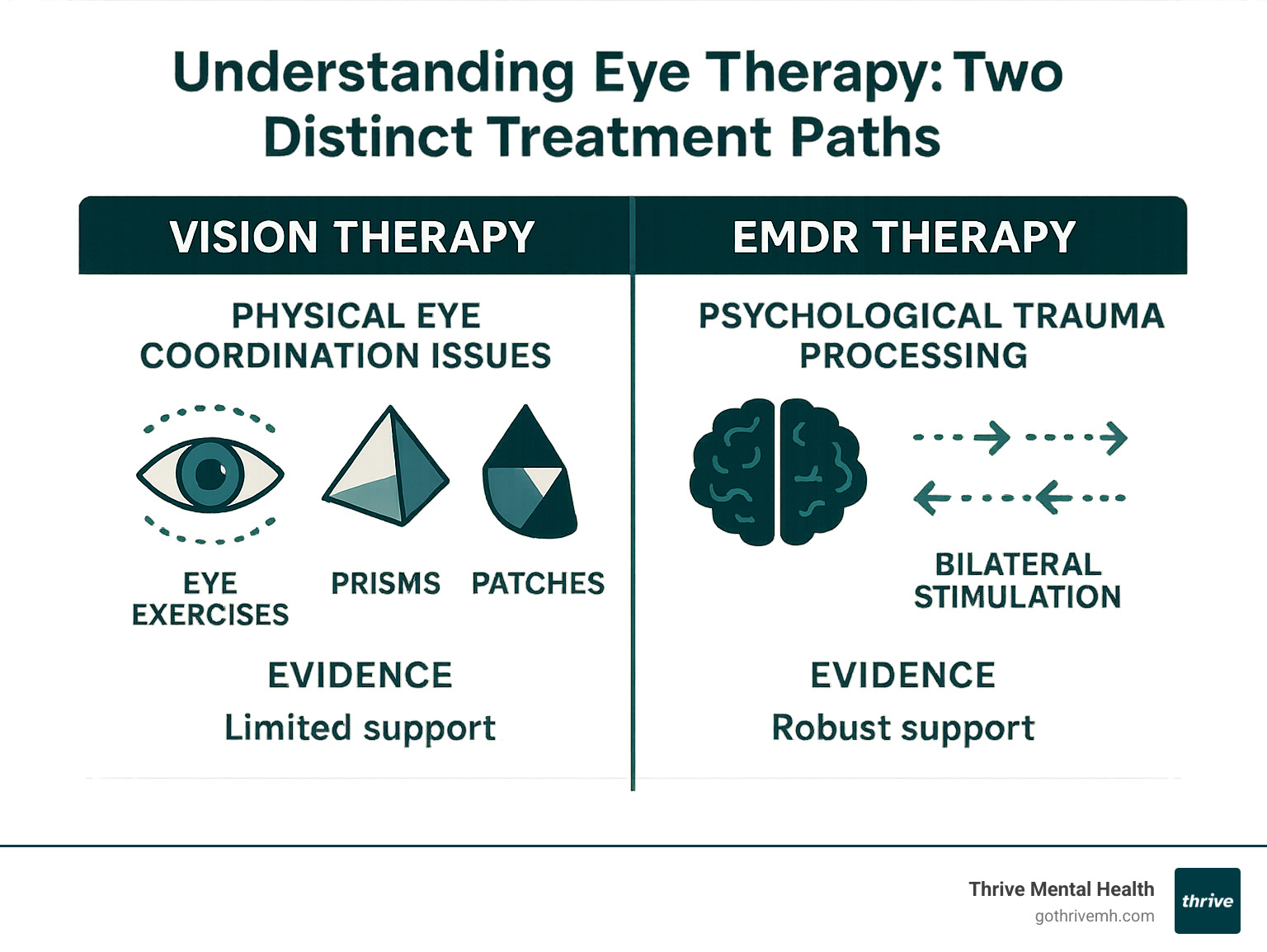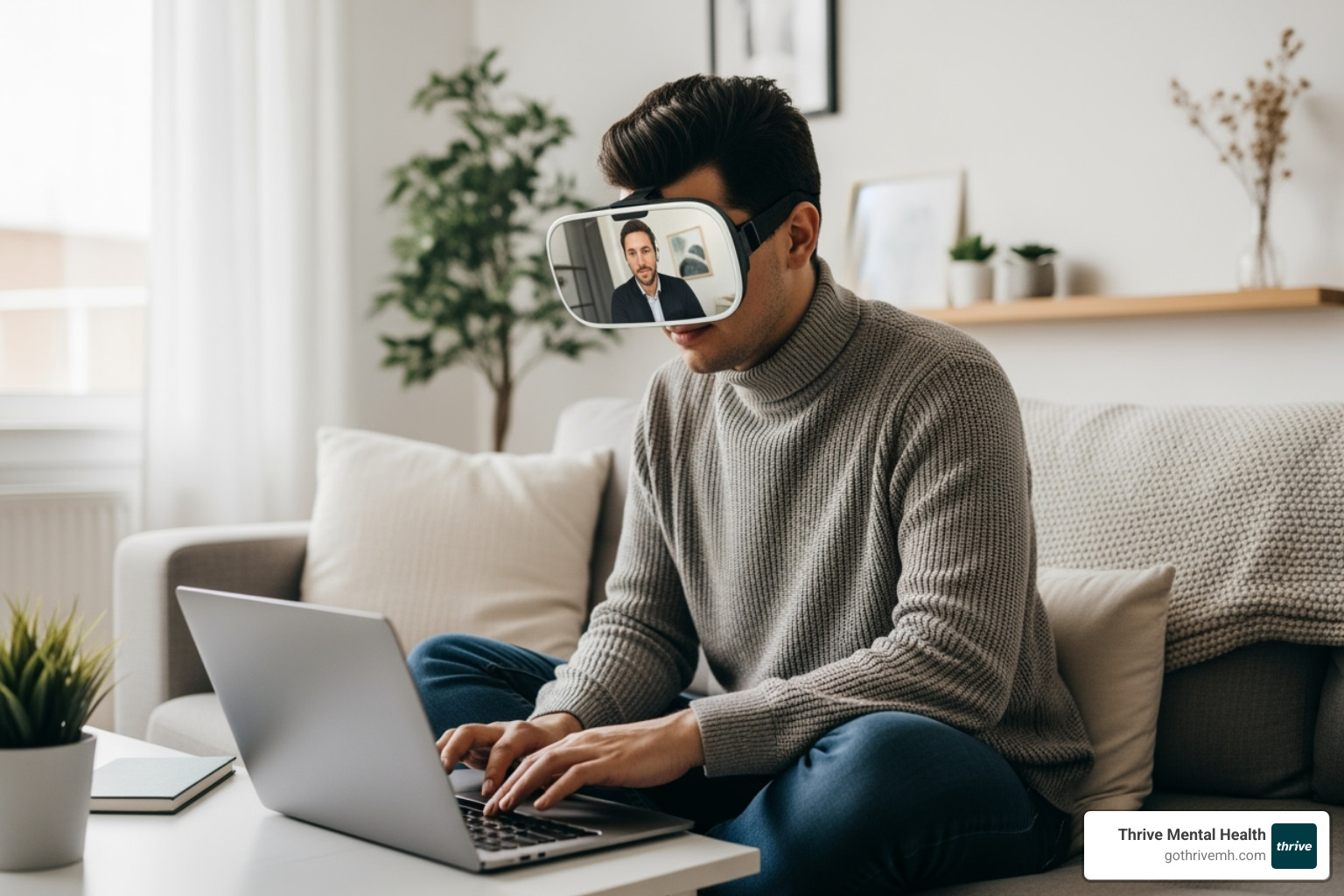Eye Therapy Roundup – Treatments Worth a Second Look

Understanding Eye Therapy: Two Distinct Treatment Paths
Eye therapy encompasses two completely different treatment approaches that share only their connection to the visual system. Many people searching for eye therapy solutions find themselves confused by conflicting information about what these treatments can and cannot accomplish.
The two main categories of eye therapy are:
- Vision Therapy – Physical exercises and techniques designed to improve eye coordination, focusing, and visual processing skills
- Eye Movement Desensitization and Reprocessing (EMDR) – A psychological treatment using bilateral eye movements to help process trauma and emotional distress
Vision therapy targets physical eye function issues like convergence insufficiency, amblyopia (lazy eye), and strabismus (crossed eyes). It involves supervised exercises, specialized lenses, and training programs typically lasting weeks to months.
EMDR, on the other hand, is a mental health treatment that uses guided eye movements to help reprocess traumatic memories and reduce psychological symptoms like PTSD, anxiety, and phobias.
The key distinction: Vision therapy aims to improve how your eyes work together physically, while EMDR uses eye movements as a tool to heal emotional trauma and mental health conditions.
Understanding this difference is crucial because the scientific evidence, professional qualifications, and treatment goals vary dramatically between these approaches. Some vision therapy claims lack strong scientific support, while EMDR is recognized by major health organizations as an effective trauma treatment.
As CEO of Thrive Mental Health and someone who has worked extensively in healthcare innovation, I’ve seen how eye therapy terminology creates confusion between legitimate vision treatments and evidence-based psychological interventions. My experience bridging behavioral health with broader healthcare has shown me the importance of distinguishing between these distinct treatment modalities.

Related content about eye therapy:
Vision Therapy for Physical Eye Function: A Critical Look
When people search for eye therapy to address physical vision problems, they’re usually looking for what professionals call Vision Therapy. Think of it as physical therapy for your visual system – but it’s far more sophisticated than simple eye exercises.
What is Vision Therapy?
Vision therapy goes way beyond the old “follow my finger” exercises you might remember from childhood. It’s a carefully designed, progressive program supervised by qualified eye care professionals, typically optometrists who specialize in this field.
The magic behind vision therapy lies in neuroplasticity – your brain’s remarkable ability to rewire itself and form new connections throughout your life. Here’s what many people don’t realize: your eye muscles are already incredibly strong. Vision therapy isn’t about strengthening them further.
Instead, this form of eye therapy focuses on retraining the learned aspects of vision and improving how your brain processes visual information. It’s about enhancing the communication highway between your eyes and your brain.
A typical vision therapy program combines in-office sessions (usually once or twice weekly) with prescribed at-home exercises. During sessions, you’ll work with specialized tools like therapeutic lenses, prisms, filters, and patches. Some programs even use electronic targets with timing mechanisms and balance boards to create specific visual challenges.
The goal isn’t just clearer vision – it’s developing fundamental visual skills that make seeing comfortable, easy, and efficient. This matters because not all vision problems can be fixed with regular glasses or contact lenses, especially when the issue stems from coordination problems or how your brain interprets what you see.
Types of Vision Therapy and Conditions Treated
The world of vision therapy splits into two main approaches, and understanding the difference is crucial for making informed decisions about treatment.
| Feature | Orthoptic Vision Therapy | Behavioral Vision Therapy |
|---|---|---|
| Focus | Evaluation and non-surgical treatment of binocular vision and eye movement disorders. | Aims to treat broader visual-perceptual problems, often linked by proponents to learning issues, visual attention, and concentration. |
| Conditions | Convergence Insufficiency, Strabismus, Amblyopia, Accommodative Insufficiency. | Claims to address visual issues related to learning disabilities, dyslexia, ADHD (often controversial). |
| Evidence Base | Strong scientific evidence for specific conditions (e.g., Convergence Insufficiency). | Largely lacks robust scientific evidence for many of its broader claims, considered controversial by mainstream medical organizations. |
| Practitioners | Orthoptists (work with ophthalmologists), some optometrists. | Primarily optometrists specializing in behavioral optometry, some occupational therapists. |
Orthoptic therapy tackles specific, measurable eye coordination problems with solid scientific backing. The star condition here is Convergence Insufficiency – affecting about 5-15% of children and adults. If you’ve ever experienced eyestrain, headaches, or double vision while reading, this might sound familiar. Your eyes struggle to turn inward and work together for close-up tasks.
The good news? Research like the Convergence Insufficiency Treatment Trial shows strong evidence that orthoptic therapy really works for this condition. You can learn more about the scientific research on Convergence Insufficiency.
Amblyopia (lazy eye) represents another success story for this type of eye therapy. When your brain favors one eye over the other, vision therapy can help strengthen the weaker eye and improve coordination – sometimes involving patching the stronger eye to give the weaker one a chance to develop.
Strabismus (crossed eyes) also responds well to vision therapy, especially milder forms. The treatment helps improve eye alignment and coordination, often as part of a comprehensive treatment plan.
Behavioral vision therapy casts a much wider net, making broader claims about treating visual problems connected to learning disabilities, dyslexia, and ADHD. It also addresses conditions like computer vision syndrome and visual issues related to developmental conditions.
The Scientific Debate on This Type of Eye Therapy

Here’s where eye therapy gets complicated. There’s an ongoing scientific debate between some optometric organizations promoting behavioral vision therapy and major medical organizations like the American Academy of Ophthalmology (AAO) and American Academy of Pediatrics (AAP).
The controversy centers on claims about treating learning disabilities, dyslexia, and ADHD through vision therapy. Unfortunately, many of these claims lack robust scientific support. A comprehensive review found insufficient controlled studies to support broad behavioral approaches, while a 2008 analysis concluded these approaches “are not evidence-based, and thus cannot be advocated.” For a deeper dive, check out this critical evaluation of behavioral vision therapy.
Major medical organizations consistently emphasize that dyslexia is language-based, not vision-based. With the notable exception of convergence insufficiency, there’s little scientific evidence that vision therapy can effectively treat learning disabilities or boost academic performance.
This doesn’t mean all vision therapy is questionable – quite the opposite. For conditions like convergence insufficiency, the evidence is rock-solid and widely accepted across medical disciplines.
The takeaway? Always seek evidence-based treatment and ask for scientific information showing how any prescribed therapy helps with your specific problem. This is especially important for complex issues like learning difficulties, where the claims can be tempting but the science may not support them.
When exploring any form of eye therapy, work with professionals who adhere to recognized scientific standards and can clearly explain the evidence behind their treatment recommendations.
A Different Approach: Eye Movement Therapy for Mental Wellness
While vision therapy focuses on how your eyes physically work together, there’s an entirely different type of eye therapy that has nothing to do with improving your eyesight. Instead, it harnesses the power of eye movements to heal emotional wounds and process traumatic experiences. This approach opens up a completely different pathway to wellness through Eye Movement Desensitization and Reprocessing, or EMDR therapy.

What is Eye Movement Desensitization and Reprocessing (EMDR)?
EMDR represents a fascinating intersection where eye therapy meets mental health treatment. Developed by psychologist Francine Shapiro in the late 1980s, this groundbreaking therapy uses bilateral stimulation—typically guided eye movements—to help your brain reprocess traumatic memories in a healthier way.
Think of EMDR as a reset button for your brain’s memory filing system. When we experience trauma, our brains sometimes struggle to properly store and process these difficult memories. They can become “stuck,” causing flashbacks, nightmares, and intense emotional reactions that feel as fresh and overwhelming as when the original event occurred.
The therapy works through what’s called the Adaptive Information Processing (AIP) model. This approach recognizes that your brain has a natural ability to heal from psychological trauma, much like your body heals from physical wounds. Sometimes, though, traumatic experiences overwhelm this natural healing process, leaving memories improperly stored and continuing to cause distress.
During EMDR sessions, you’ll focus on a distressing memory while following your therapist’s finger with your eyes as it moves back and forth. This bilateral stimulation appears to mimic what happens during REM sleep, when your brain naturally processes and integrates memories. The goal isn’t to erase memories, but to help your brain file them away in a way that reduces their emotional charge and power over your daily life.
For more detailed information about this powerful therapy approach, you can explore: More info about EMDR therapy.
How This Form of Eye Therapy Heals Trauma

While EMDR gained recognition for treating PTSD, its healing power extends far beyond single traumatic events. This form of eye therapy has proven effective for a wide range of mental health conditions that stem from difficult life experiences.
Anxiety and panic attacks often respond well to EMDR, especially when they’re rooted in specific triggering events. People struggling with phobias find that EMDR can help reduce the intense fear responses that seem to come out of nowhere. Depression linked to past experiences, complicated grief from losing someone important, and even chronic pain that has psychological components can all benefit from this approach.
The healing process works on multiple levels simultaneously. As you engage in bilateral stimulation while focusing on the traumatic memory, several important changes begin to happen. The intense emotional distress that floods your system when you think about the event starts to decrease. Those overwhelming feelings of fear, helplessness, or rage begin to lose their grip.
Perhaps even more importantly, EMDR helps change the negative beliefs that trauma often leaves behind. Instead of carrying messages like “I’m not safe” or “It’s all my fault,” you can develop more balanced, realistic perspectives about yourself and what happened. The memory doesn’t disappear, but it transforms from a source of ongoing pain into simply part of your history.
What makes EMDR particularly appealing is that you don’t always need to talk extensively about the traumatic event. Some people find it difficult or retraumatizing to describe their experiences in detail. EMDR allows your brain to do the processing work without requiring you to verbalize everything that happened.
Many people are surprised by how quickly EMDR can create meaningful change. While traditional talk therapy might take months or years to address trauma symptoms, EMDR often produces noticeable improvements in just a few sessions. To learn more about the specific ways EMDR reduces trauma symptoms and supports mental wellness, check out: How EMDR Therapy Reduces PTSD Symptoms and Boosts Mental Health.
Who Provides EMDR and What Do Sessions Involve?
EMDR therapy requires specialized training and must be provided by licensed mental health professionals who have completed comprehensive EMDR certification programs. This ensures you receive safe, effective treatment that follows established protocols and ethical guidelines.
The therapy follows a structured eight-phase approach that creates a safe container for processing difficult memories. Your journey begins with history-taking and treatment planning, where your therapist learns about your background and identifies which memories to target. The preparation phase focuses on building your emotional resources and teaching coping skills you can use if distress arises during or between sessions.
During the assessment phase, you’ll work together to identify the specific memory, along with the negative beliefs, emotions, and physical sensations connected to it. This is followed by the desensitization phase—the heart of EMDR where bilateral stimulation occurs. You’ll focus on the distressing memory while following your therapist’s guidance through eye movements or other forms of bilateral stimulation until the emotional charge decreases significantly.
The installation phase strengthens positive, adaptive beliefs about yourself in relation to the memory. A body scan checks for any remaining physical tension or sensations, processing them until your body feels neutral when thinking about the event. Each session ends with closure, ensuring you leave feeling stable and grounded. Reevaluation at the beginning of subsequent sessions tracks your progress and identifies new targets if needed.
Most people complete EMDR therapy in six to twelve sessions, typically meeting once or twice weekly. Some individuals with complex trauma may need more sessions, while others find significant relief more quickly. The beauty of EMDR is that it can be delivered effectively through both in-person and virtual therapy formats, making this powerful treatment accessible regardless of your location or schedule.
At Thrive Mental Health, our expert-led programs integrate EMDR into comprehensive treatment approaches, whether you’re participating in our intensive outpatient or partial hospitalization programs. Choosing the right EMDR therapist is an important decision that can significantly impact your healing journey. For guidance on making this choice, explore: Choosing the Right EMDR Therapist: Tips and Considerations.
Frequently Asked Questions about Vision and Eye Therapies
When people search for eye therapy, they often have questions about what different treatments can actually accomplish. The confusion between vision therapy and EMDR creates many misconceptions. Let me address the most common questions I encounter in my work with patients seeking clarity about these distinct approaches.
Can vision therapy cure learning disabilities or dyslexia?
This is perhaps the most important question to address clearly: No, vision therapy cannot cure learning disabilities or dyslexia. While this might disappoint some parents hoping for a simple solution, understanding the science behind this answer is crucial for making informed treatment decisions.
Dyslexia is fundamentally a language-based learning disability that originates in how the brain processes language, not in how the eyes function. Research consistently shows that children with dyslexia typically have normal eye coordination, eye movement, and visual processing abilities. The reading difficulties stem from challenges in phonological processing, decoding, and other language-related brain functions.
The scientific consensus on this topic is remarkably clear. Major medical organizations including the American Academy of Pediatrics (AAO), American Academy of Ophthalmology, and American Association for Pediatric Ophthalmology and Strabismus have issued joint statements emphasizing that eye exercises or behavioral vision therapy has not been proven to improve academic performance in children with learning disabilities. You can read more in the Joint statement on learning disabilities from the AAO.
However, vision problems can certainly coexist with learning disabilities. A child might struggle with reading due to undiagnosed convergence insufficiency, making their eyes too strained to focus comfortably on text. This isn’t dyslexia – it’s a treatable vision condition that, once addressed, can eliminate the visual barriers to learning.
This is why a comprehensive eye examination by a qualified eye care professional is always recommended when a child struggles academically. School vision screenings miss up to half of significant vision problems, so professional evaluation ensures any actual vision issues are identified and treated appropriately.
Is vision therapy suitable for both children and adults?
Yes, vision therapy can benefit both children and adults, thanks to our brain’s remarkable neuroplasticity – its ability to form new connections and adapt throughout our lives. While many people associate eye therapy primarily with childhood treatments, adults can achieve significant improvements in visual function as well.
Children often receive vision therapy for conditions like amblyopia (lazy eye) and strabismus (crossed eyes), where early intervention typically yields the best results. The developing visual system in children is particularly responsive to therapeutic interventions, making childhood an optimal time for treatment when these conditions are present.
Adults can also experience meaningful improvements through vision therapy programs. Convergence insufficiency, for example, responds well to treatment in adult populations, with research supporting its effectiveness across age groups. Adults who develop vision problems after head injuries or concussions often find relief through targeted vision therapy approaches.
Post-traumatic vision issues represent a growing area where adult vision therapy shows promise. Whether from sports injuries, accidents, or other trauma, adults can work to retrain their visual system and reduce symptoms like double vision, focusing difficulties, or eye strain.
The timeline for improvement varies by individual and condition, but many people notice positive changes within a few weeks, with optimal results typically achieved over several months of consistent treatment.
Is EMDR a scientifically recognized treatment?
Absolutely – EMDR is widely recognized as an evidence-based, scientifically validated treatment. Unlike some claims made for certain types of vision therapy, EMDR has robust research support and endorsement from major health organizations worldwide.
The scientific backing for EMDR is impressive. The World Health Organization (WHO), American Psychiatric Association (APA), U.S. Department of Veterans Affairs, and U.S. Department of Defense all recognize and recommend EMDR as an effective treatment for trauma and PTSD. This level of institutional support reflects decades of rigorous research demonstrating its effectiveness.
Controlled trials consistently show EMDR’s effectiveness in treating PTSD and other trauma-related conditions. The research base includes randomized controlled trials, meta-analyses, and long-term outcome studies that demonstrate not just immediate benefits, but lasting improvements in trauma symptoms.
What makes EMDR particularly valuable is its effectiveness for people who struggle with traditional talk therapy approaches. Some individuals find it difficult to verbally process their traumatic experiences, and EMDR offers an alternative pathway to healing that doesn’t require extensive verbal recounting of traumatic events.
While researchers continue studying exactly how EMDR works neurologically, there’s strong consensus that it does work effectively. Its outcomes are comparable to, and sometimes superior to, other established trauma therapies, making it a cornerstone treatment in modern trauma-informed care.
At Thrive Mental Health, we’ve seen how this form of eye therapy helps people move from trauma to healing, which is why EMDR is a key component of our evidence-based treatment programs.
Conclusion: Finding the Right Path to Wellness
As we’ve explored, the term “eye therapy” encompasses two distinct and powerful treatment paths: vision therapy for physical eye function and Eye Movement Desensitization and Reprocessing (EMDR) for mental wellness. Understanding the unique goals, methods, and scientific backing of each is crucial for making informed decisions about your health.
For issues related to how your eyes physically work together, focus, and track, vision therapy, often provided by optometrists, can be a highly effective solution, especially for conditions like convergence insufficiency, amblyopia, and strabismus. It’s important to seek professionals who provide evidence-based vision therapy and to be wary of broad, unproven claims.
For healing from trauma and addressing related mental health conditions, EMDR therapy, delivered by licensed and trained mental health professionals, offers a scientifically validated approach to reprocessing distressing memories and fostering emotional well-being.
Finding the right path to wellness means consulting with qualified professionals. For vision concerns, a comprehensive eye exam with an optometrist or ophthalmologist is the first step. For mental health challenges, particularly those rooted in trauma, reaching out to a licensed therapist specializing in evidence-based modalities like EMDR is essential.
At Thrive Mental Health, we are committed to providing flexible, expert-led, and evidence-based care custom to individual needs. Our virtual and in-person intensive outpatient (IOP) and partial hospitalization (PHP) programs for adults and young professionals include effective treatments like EMDR, designed to support your journey towards healing and personal growth. We believe in empowering you with the knowledge and tools to thrive, accessible from anywhere.

If you or a loved one are struggling with the lingering effects of trauma, we invite you to learn more about our evidence-based EMDR therapy programs: Learn more about our evidence-based EMDR therapy programs.